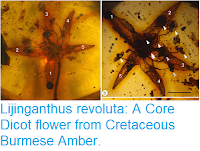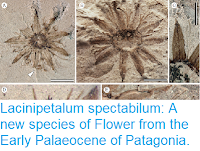Flowering Plants, Angiosperms, are the dominant group of Plants in almost all terrestrial (and many freshwater and marine) environments today. They rose to this dominance early in the Cretaceous, leading palaeontologists to assume that they first appeared in the Jurassic as early as the nineteenth century. However, for a long time no Jurassic flowers could be found in the fossil record, leading many to question the validity of this assumption, and while several Jurassic flowers have been described in recent decades, these are all known from single specimens, leaving the possibility that these are other structures that have been misinterpreted.
In a paper published in the journal eLife on 18 December 2018, Qiang Fu of the Key Laboratory of Economic Stratigraphy and Paleogeography at the Nanjing Institute of Geology and Palaeontology and Center for Excellence in Life and Paleoenvironment of the Chinese Academy of Sciences, Jose Bienvenido Diez of the Departamento de Geociencias at the Universidade de Vigo, Mike Pole of the Queensland Herbarium at the Brisbane Botanical Gardens Mt Coot-tha, Manuel García Ávila, also of the Departamento de Geociencias, and of the Facultade de Bioloxía of the Asociación Paleontolóxica Galega at the Universidad de Vigo, Zhong-Jian Liu of the State Forestry Administration Key Laboratory of Orchid Conservation and Utilization at Fujian Agriculture and Forestry University, Hang Chu of the Tianjin Center of the China Geological Survey, Yemao Hou and Pengfei Yin of the Key Laboratory of Vertebrate Evolution and Human Origin at the Institute of Vertebrate Paleontology and Paleoanthropology and Center for Excellence in Life and Paleoenvironment of the Chinese Academy of Sciences, Guo-Qiang Zhang, also of the State Forestry Administration Key Laboratory of Orchid Conservation and Utilization at Fujian Agriculture and Forestry University, Kaihe Du of the Jiangsu Key Laboratory for Supramolecular Medicinal Materials and Applications at Nanjing Normal University, and Xin Wang, also of the Key Laboratory of Economic Stratigraphy and Paleogeography at the Nanjing Institute of Geology and Palaeontology and Center for Excellence in Life and Paleoenvironment of the Chinese Academy of Sciences, describe a Flower from the Early Jurassic South Xiangshan Formation of Nanjing in Jiangsu Province, China, of which 264 specimens of 198 individual Flowers preserved on 34 slabs in various states and orientations, leaving no doubt as the status of this Plant as an Angiosperm.
The South Xiangshan Formation is a collection of sandstones, siltstones, shales, carbonaceous shales, and coal seams, which has produced numerous Plant and Bivalve fossils. The formation outcrops at several sites around the city of Nanjing in Jiangsu Province, China. It forms the lower part of the Xiangshan Group (the upper part being assigned to the rather less fossiliferous North Xiangshan Formation). The flora of the South Xiangshan Formation is similar to that of the Hsiangchi Group in western Hubei Province, being dominated by Cycads, with numerous Ferns and Gingkoes. As well as Plant macrofossils, pollen is very common in the South Xiangshan Formation, and has been used to date the formation to the late Early Jurassic, while a variety of isotopic geochemical dates have been obtained from zircons derived from the formation, with the youngest being Late Triassic in origin, implying that the formation can be no older than Late Triassic.
The Plant is named Nanjinganthus dendrostyla, where ‘Nanjinganthus’ means ‘Flower of Nanjing’ and ‘dendrostyla’ means ‘tree-like style’ a reference to the style of the flower, which is long and branching. The flowers are preserved in a variety of states, and at many different angles, enabling a good understanding of their structure. Some of the Flowers fused bracts at their bases, with a cup-like structure above this holding an enclosed ovary, above this four-five sepals, then four-five petals and then the branching style.
The South Xiangshan Formation is a collection of sandstones, siltstones, shales, carbonaceous shales, and coal seams, which has produced numerous Plant and Bivalve fossils. The formation outcrops at several sites around the city of Nanjing in Jiangsu Province, China. It forms the lower part of the Xiangshan Group (the upper part being assigned to the rather less fossiliferous North Xiangshan Formation). The flora of the South Xiangshan Formation is similar to that of the Hsiangchi Group in western Hubei Province, being dominated by Cycads, with numerous Ferns and Gingkoes. As well as Plant macrofossils, pollen is very common in the South Xiangshan Formation, and has been used to date the formation to the late Early Jurassic, while a variety of isotopic geochemical dates have been obtained from zircons derived from the formation, with the youngest being Late Triassic in origin, implying that the formation can be no older than Late Triassic.
The Plant is named Nanjinganthus dendrostyla, where ‘Nanjinganthus’ means ‘Flower of Nanjing’ and ‘dendrostyla’ means ‘tree-like style’ a reference to the style of the flower, which is long and branching. The flowers are preserved in a variety of states, and at many different angles, enabling a good understanding of their structure. Some of the Flowers fused bracts at their bases, with a cup-like structure above this holding an enclosed ovary, above this four-five sepals, then four-five petals and then the branching style.
Flowers of Nanjinganthus dendrostyla preserved in different states and their details. Scale bars are 1 mm except otherwise annotated. (A) Numerous flowers preserved on a single slab. Some of the numbered ones are detailed in later figures. Scale bar is 1 cm. (B) Numerous coalified flowers on the same slab. Scale bar is 1 cm. (C) Bottom view of Flower 1 in (A) showing five sepals ‘s’ and five petals ‘p’ with longitudinal ribs. (D) Bottom view of Flower 2 in (A) showing four sepals ‘s’ and four petals ‘p’ with longitudinal ribs. (E) Bottom view of a flower, showing a sepal (s) and three petals (p) radiating from the center, which is obliquely broken to show the relationship among the sepals and petals as in (J). (F) Top view of Flower with sepals ‘s’, petals ‘p’, and seeds (arrow) inside the receptacle. (G) Side view of a flower bud (Flower 1 in (B)) with longitudinal ribs (arrows) on the sepals ‘s’ and petals ‘p’. (H) Side view of Flower, showing a receptacle ‘h’, perianth (black arrows), and a dendroid style (white arrow). (I) Side view of Flower, without sepals or petals. Scale bar is 1 mm. (J) Detailed view of the flower shown in (e), showing the arrangement of three petal bases ‘1’-‘3’ inside the sepals (s). These petals bases correspond to the three petals ‘1’-‘3’ in (e). Fu et al. (2018).
Dendroid styles are known in a number of extant Angiosperm groups, including Mallows, Passionflowers, Grasses and Euphorbias, though these are all highly derived groups, not thought to be close to the base of the Angiosperm family tree, and the presence of a similar structure in Nanjinganthus dendrostyla is assumed to be the result of parallel evolution rather than an indication of a close relationship. Instead Fu et al. believe Nanjinganthus dendrostyla should be regarded as a stem-group Angiosperm, i.e. Flowering Plant which lived before the last common ancestor of all living members of the group, and which may-or-may-not have been ancestral to it.
Idealized reconstruction of Nanjinganthus dendrostyla. (1) Branches of dendroid style; (2) dendroid style; (3) sepal; (4) ovarian roof; (5) scale; (6) seed; (7) cup-form receptacle/ovary; (8) bract; (9) petal; (10) unknown organ (staminode?). Fu et al. (2018).
See also...
Follow Sciency Thoughts on Facebook.








